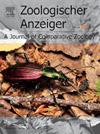The flow of non-indigenous species continues in the north Adriatic Sea: Cerastoderma edule and Mytilopsis leucophaeata (Mollusca: Bivalvia) are invading the Sacca di Goro lagoon
IF 1.5
3区 生物学
Q2 ZOOLOGY
引用次数: 0
Abstract
The spread of non-indigenous species (NIS) is a major threat to native biodiversity worldwide. The Mediterranean Sea is particularly affected by such a phenomenon, with high introduction rates and harmful consequences on its biota and ecosystems. Based on an integrative taxonomic approach, we hereby report the widespread occurrence of two NIS bivalves (Cerastoderma edule and Mytilopsis leucophaeata) in the Sacca di Goro Lagoon (Italy, north Adriatic Sea). The record of the former species is the first for Italy and the Mediterranean Sea sensu stricto, and also accounts for the first confirmed evidence of this species invading new areas worldwide, whilst that of the latter potentially clarifies the taxonomic uncertainties regarding the species that has invaded the north Adriatic until 2008. Although there are no certainties regarding their introduction pathways, C. edule was most likely introduced with seeding activities together with clam larvae or juveniles, while M. leucophaeata may have arrived through natural currents from nearby populations or amidst fouling communities of natural/anthropogenic floating objects or recreational vessels. Finally, although the local impact of these two new NIS is still unpredictable, C. edule can achieve extraordinarily high densities and has a structural role as a habitat engineer, influencing the distribution of surface sediments, while M. leucophaeata can foul and clog anthropogenic substrates and outgrow and replace benthic species. A careful monitoring of the area during the next years is therefore necessary to evaluate the consequences of these new introductions.
非本地物种的流动在北亚得里亚海继续:甲壳类动物(Cerastoderma edule)和白食mytillopsis leucophaeata(软体动物:双壳纲)正在入侵Sacca di Goro泻湖
非本地物种(NIS)的传播是全球本地生物多样性的主要威胁。这种现象对地中海的影响尤其大,引进率高,对其生物群和生态系统造成有害后果。基于综合分类方法,我们报道了在意大利北部亚得里亚海Sacca di Goro泻湖广泛分布的两种NIS双壳类(Cerastoderma edule和mytillopsis leucophaeata)。前一个物种的记录是意大利和地中海严格意义上的第一个记录,也是该物种入侵世界新地区的第一个确认证据,而后者的记录可能澄清了直到2008年入侵亚得里亚海北部的物种的分类不确定性。虽然它们的引入途径尚不确定,但它们最有可能是与蛤蜊幼虫或幼体一起进行种子活动而引入的,而白藻可能是通过附近种群的自然水流或自然/人为漂浮物或娱乐船只的污染群落而引入的。最后,尽管这两种新的NIS对当地的影响仍然不可预测,但C. edule可以达到非常高的密度,并具有生境工程师的结构作用,影响地表沉积物的分布,而M. leucophaeata可以污染和堵塞人为基质,并超越和取代底栖生物物种。因此,有必要在今后几年对该地区进行仔细监测,以评估这些新引进的后果。
本文章由计算机程序翻译,如有差异,请以英文原文为准。
求助全文
约1分钟内获得全文
求助全文
来源期刊

Zoologischer Anzeiger
生物-动物学
CiteScore
2.80
自引率
7.10%
发文量
75
审稿时长
>12 weeks
期刊介绍:
Zoologischer Anzeiger - A Journal of Comparative Zoology is devoted to comparative zoology with a special emphasis on morphology, systematics, biogeography, and evolutionary biology targeting all metazoans, both modern and extinct. We also consider taxonomic submissions addressing a broader systematic and/or evolutionary context. The overall aim of the journal is to contribute to our understanding of the organismic world from an evolutionary perspective.
The journal Zoologischer Anzeiger invites suggestions for special issues. Interested parties may contact one of the editors.
 求助内容:
求助内容: 应助结果提醒方式:
应助结果提醒方式:


